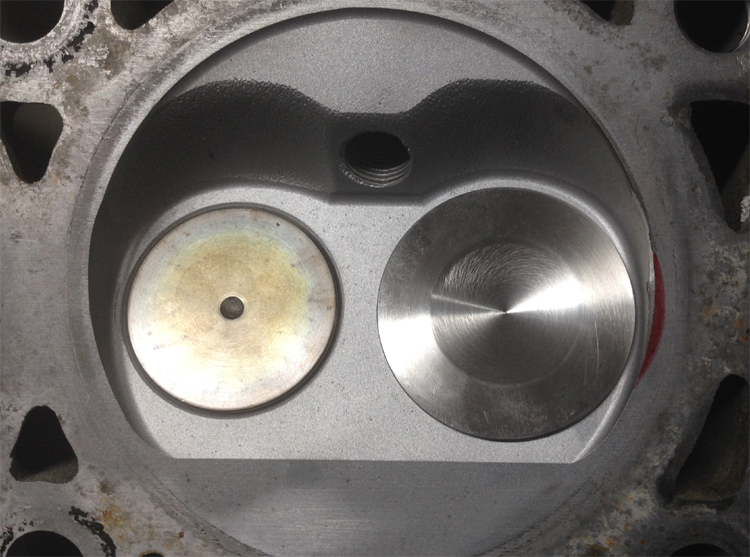Ultra High Flow, Low Cost, 8V Head Project
#32
 [/CENTER][/QUOTE]
[/CENTER][/QUOTE]Something I noticed in the combustion area... Notice that funny edge between when it goes from flat to curved up, like between the valves and the spark plug, looks like their is a weird tooling edge, might wanna try and smooth the transition better, help reduce ping and increase flow in the combustion chamber
#34
#35
Rennlist Member
Thread Starter
#36
#37
Rennlist Member
Thread Starter
#38
Rennlist Member
#39
Valves, But since your running E85 your combustion temps are probably cooler then when running normal gas.
#41
Race Car
Right on Shawn
Just an FYI.. I finally decided on sticking with an 8v head for this coming year. I just have too many other things to do before making all the changes to go 16v. I just need to get the car running again!!!
I'll be following your progress with this as I'm starting out with the 47mm valves on the current NA head.
Just an FYI.. I finally decided on sticking with an 8v head for this coming year. I just have too many other things to do before making all the changes to go 16v. I just need to get the car running again!!!
I'll be following your progress with this as I'm starting out with the 47mm valves on the current NA head.
#43
Rennlist Member
Thanks Thom. I guess this is what Voith was referring to. Be interesting and in context for this thread to compare a 2.5L to a 2.7L head in close up pics.
#44
Three Wheelin'
Spencer, that is actually what a flow bench does. It has a fixture that's the bore and stroke of the cylinder, and at the bottom of it is the connection for the blower/vacuum source. This way it mimics how the air has to travel in the cylinder filling portion of the 4-stroke cycle.
Ideally, you test the air flow with the valve at different lift points - e.g. 0.050", 0.1", 0.2", and so-forth up to the max lift, which is about .475" on these engines. This will help you put together a picture of what the theoretical flow numbers would be... with a little math, and the knowledge of your cam profile, you can figure out the volume of air that will fill the cylinder in one stroke.
Like Sid said, peak numbers can be a little deceptive... because the valve is fully opened for such a short duration. In fact, valves will spend a larger percentage of their duration close to the valve seat than wide open, so there are some good gains to get by getting a head to improve flow at 0.050" lift.
There are 2 things a flow bench is really good for: first, making sure the four cylinders are flowing evenly - this will maximize an engine's performance; second, by flowing all parts of the intake system, the most restrictive part can be identified (and corrected if necessary). If you've got great flow on the intake side of your head, but if your manifold, throttle body, AFM, turbo, intercooler, air filter, etc. can't support that much air flow, then it's all useless.
In short, a flow bench is a tool used to help make decisions about your whole system, in addition to providing a way to quantify the effect of geometry changes to an air passageway.
Ideally, you test the air flow with the valve at different lift points - e.g. 0.050", 0.1", 0.2", and so-forth up to the max lift, which is about .475" on these engines. This will help you put together a picture of what the theoretical flow numbers would be... with a little math, and the knowledge of your cam profile, you can figure out the volume of air that will fill the cylinder in one stroke.
Like Sid said, peak numbers can be a little deceptive... because the valve is fully opened for such a short duration. In fact, valves will spend a larger percentage of their duration close to the valve seat than wide open, so there are some good gains to get by getting a head to improve flow at 0.050" lift.
There are 2 things a flow bench is really good for: first, making sure the four cylinders are flowing evenly - this will maximize an engine's performance; second, by flowing all parts of the intake system, the most restrictive part can be identified (and corrected if necessary). If you've got great flow on the intake side of your head, but if your manifold, throttle body, AFM, turbo, intercooler, air filter, etc. can't support that much air flow, then it's all useless.
In short, a flow bench is a tool used to help make decisions about your whole system, in addition to providing a way to quantify the effect of geometry changes to an air passageway.
This however does not assure that the cylinders have the same volumetric efficiency in normal operation.
It's a common compromise (or naiive mistake) to balance "flows", when there are other significant effects that can't be modelled on a traditional flow bench (inertia effects, resonance etc). The goal is usually to achieve even volumetric efficiency.
Other modelling techniques must be used for this, as Porsche did for the Turbo manifold...
Cheers,
Mike
#45
Addict
Rennlist Member
Rennlist Member





